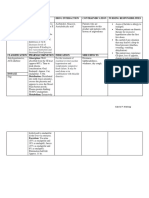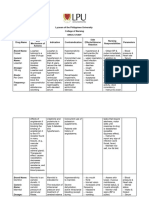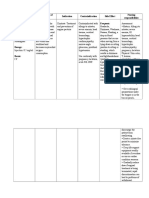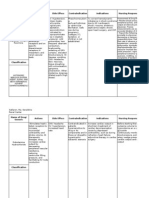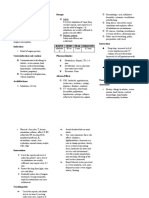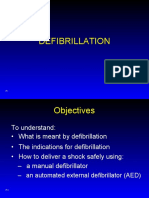0 ratings0% found this document useful (0 votes)
37 viewsDrug Study
Drug Study
Uploaded by
Keanu PeraltaThis document summarizes information about two medications - Losartan/HCTZ and Amlodipine - used to treat hypertension. It describes their mechanisms of action in lowering blood pressure by relaxing blood vessels. Common side effects include dizziness, headache, fatigue and edema. Nursing responsibilities involve baseline assessments, monitoring for side effects and complications, ensuring proper dosing, and patient/family education about medication use and signs of problems to report.
Copyright:
© All Rights Reserved
Available Formats
Download as PDF, TXT or read online from Scribd
Drug Study
Drug Study
Uploaded by
Keanu Peralta0 ratings0% found this document useful (0 votes)
37 views10 pagesThis document summarizes information about two medications - Losartan/HCTZ and Amlodipine - used to treat hypertension. It describes their mechanisms of action in lowering blood pressure by relaxing blood vessels. Common side effects include dizziness, headache, fatigue and edema. Nursing responsibilities involve baseline assessments, monitoring for side effects and complications, ensuring proper dosing, and patient/family education about medication use and signs of problems to report.
Original Title
f34ferv
Copyright
© © All Rights Reserved
Available Formats
PDF, TXT or read online from Scribd
Share this document
Did you find this document useful?
Is this content inappropriate?
This document summarizes information about two medications - Losartan/HCTZ and Amlodipine - used to treat hypertension. It describes their mechanisms of action in lowering blood pressure by relaxing blood vessels. Common side effects include dizziness, headache, fatigue and edema. Nursing responsibilities involve baseline assessments, monitoring for side effects and complications, ensuring proper dosing, and patient/family education about medication use and signs of problems to report.
Copyright:
© All Rights Reserved
Available Formats
Download as PDF, TXT or read online from Scribd
Download as pdf or txt
0 ratings0% found this document useful (0 votes)
37 views10 pagesDrug Study
Drug Study
Uploaded by
Keanu PeraltaThis document summarizes information about two medications - Losartan/HCTZ and Amlodipine - used to treat hypertension. It describes their mechanisms of action in lowering blood pressure by relaxing blood vessels. Common side effects include dizziness, headache, fatigue and edema. Nursing responsibilities involve baseline assessments, monitoring for side effects and complications, ensuring proper dosing, and patient/family education about medication use and signs of problems to report.
Copyright:
© All Rights Reserved
Available Formats
Download as PDF, TXT or read online from Scribd
Download as pdf or txt
You are on page 1of 10
DRUG STUDY
MEDICATION INDICATION MECHANISM OF MECHANISM OF SIDE EFFECTS AND NURSING RESPONSIBILITIES
ACTION ACTION IN ADVERSE EFFECTS
RELATION TO
THE PATIENT’S
CASE
LOSARTAN + HCTZ Hypertension Hydrochlorothiazide The drug works Side Effects: BASELINE ASSESSMENT
50/12.5 MG increases renal in high blood dizziness or Obtain B/P, apical pulse
excretion of sodium pressure by lightheadedness as immediately before each
Generic Name: and chloride and relaxing and your body adjusts dose, in addition to regular
Losartan potassium- reduces cardiac widening blood to the medication, monitoring (be alert to
hydrochlorothiazide load. Losartan is an vessels. This stomach pain, fluctuations).
Brand Name: angiotensin II lowers the back pain, tired INTERVENTION/EVALUATION
Hyzaar receptor (type AT1) patient’s blood feeling, skin rash, Maintain hydration (offer
antagonist pressure and runny or stuffy nose, fluids frequently).
antihypertensive makes it easier sore throat, or dry Assess for evidence of
which acts by for the heart to cough. upper respiratory infection,
blocking the pump blood Adverse Side cough.
actions of around your Effects: Monitor B/P, pulse. If
angiotensin II of body. Volume depletion excessive reduction in B/P
renin-angiotensin- and electrolyte occurs, place pt in supine
aldosterone system. imbalance position, feet
The drug and its (especially slightly elevated. Assist with
active metabolite hyperkalaemia); ambulation if dizziness
selectively block dry mouth, thirst; occurs.
the vasoconstrictor lethargy, Monitor daily pattern of
and aldosterone drowsiness; muscle bowel activity, stool
secreting effects of pain and cramps; consistency.
angiotensin II. The rashes, PATIENT/FAMILY TEACHING
two drugs exert photosensitivity, • Report any sign of
additive effects in thrombocytopenia, infection (sore throat,
hypertension. jaundice, fever), chest pain.
Therapeutic pancreatitis; • Do not take OTC cold
indication: fatigue, weakness; preparations, nasal
Decrease B/P may precipitate an decongestants.
attack of gout; • Do not stop taking
impotence; medication.
hyperglycaemia; • Limit salt intake
anorexia, nausea,
vomiting,
constipation,
diarrhoea;
sialdenitis; raised
urinary calcium
concentration;
headache,
dizziness; back
pain, myalgia; first-
dose hypotension;
angiodema;
neutropenia; GI
disturbances;
transient elevation
of liver enzymes;
taste disturbances,
cough;
exacerbation or
activation of
systemic lupus
erythematous;
palpitations;
xanthopsia;
leucopenia,
agranulocytosis,
aplastic anaemia;
necrotising angiitis;
glucosuria; renal
dysfunction,
interstitial nephritis,
renal failure;
migraine;
hyponatraemia;
UTI; chest pain;
gastritis, wt gain,
dyspepsia,
abdominal pain;
bronchitis, upper
respiratory
infection, nasal
congestion, sinusitis;
rise in cholesterol
and/or
triglycerides.
MEDICATION INDICATION MECHANISM OF MECHANISM OF SIDE EFFECTS AND NURSING RESPONSIBILITIES
ACTION ACTION IN ADVERSE EFFECTS
RELATION TO THE
PATIENT’S CASE
AMLODIPINE Hypertension Inhibits influx of The drug works in Side Effects: BASELINE ASSESSMENT
Generic Name: extracellular high blood Peripheral Assess baseline
Amlodipine calcium ions, pressure by edema, renal/hepatic function
Brand Name: thereby relaxing and headache, tests, B/P, apical pulse.
Apo-Amlodipine; decreasing widening blood flushing. Dizziness, INTERVENTION/EVALUATION
Norvasc; Katerzia myocardial vessels. This lowers palpitations, Assess B/P (if systolic B/P is
contractility, the patient’s nausea, unusual less than 90 mm Hg,
relaxing coronary blood pressure fatigue or withhold medication,
and vascular and makes it weakness contact physician). Assess
muscles, and easier for the (asthenia). for peripheral edema
decreasing heart to pump Adverse Side behind medial malleolus
peripheral blood around Effects: (sacral area in bedridden
resistance your body. Overdose may pts). Assess skin for flushing.
Therapeutic produce Question for headache,
outcome: excessive asthenia.64 amoxicillin
Decreased B/P peripheral underlined – top
vasodilation, prescribed drug
marked PATIENT/FAMILY TEACHING
hypotension with • Do not abruptly
reflex discontinue medication.
tachycardia, • Compliance with
syncopy therapy regimen is
essential to control
hypertension.
• Avoid tasks that require
alertness, motor skills until
response to drug is
established.
• Do not ingest grapefruit
products.
• Advise patient to avoid
hazardous activities until
stabilized on product,
dizziness is no longer a
problem
• Instruct patient to avoid
alcohol and OTC
products unless directed
by prescriber
• Advise patient to
comply in all areas of
medical regimen: diet,
exercise, stress reduction,
smoking cessation,
product therapy; to notify
prescriber of irregular
heartbeat, shortness of
breath, swelling of feet,
face, and hands, severe
dizziness, constipation,
nausea, hypotension; use
nitroglycerin when angina
is severe
• Teach patient to use as
directed even if feeling
better; may be taken with
other cardiovascular
products (nitrates, b-
blockers)
• Advise to avoid large
amounts of grapefruit
juice or alcohol
MEDICATION INDICATION MECHANISM OF MECHANISM OF SIDE EFFECTS AND NURSING RESPONSIBILITIES
ACTION ACTION IN ADVERSE EFFECTS
RELATION TO THE
PATIENT’S CASE
TRAMADOL 50 MG Indication: Binds to mu-opioid In the spinal cord, Side Effects: BASELINE ASSESSMENT
Management of receptors, inhibits opioids act on Frequent: Assess onset, type,
Generic Name: moderate to reuptake of specific receptors Dizziness, vertigo, location, duration of pain.
Tramadol moderately norepinephrine, located in pre- nausea, Assess drug history, esp.
Brand Name: severe pain. serotonin, and postsynaptic constipation, carbamazepine,
Ultram, Tramadol Extended- inhibiting synapses in the headache, analgesics, CNS
Hydrochloride ER, Release: Around- ascending and dorsal horn. Pre drowsiness. depressants, MAOIs.
Tramal, Ultram ER the-clock descending pain synaptically, Occasional: Review past medical
management of pathways. opioids decrease Vomiting, pruritus, history, esp. epilepsy,
moderate to Therapeutic Effect: the release of CNS stimulation seizures. Assess renal
moderately Reduces pain. specific pain (e.g., nervousness, function, LFT.
severe pain for neurotransmitters anxiety, agitation, INTERVENTION/EVALUATION
extended period. (i.e. substance P), tremor, euphoria, Monitor pulse, B/P,
while in the mood swings, renal/hepatic function. Dry
postsynaptic hallucinations), crackers, cola may relieve
neuron they asthenia, nausea. Palpate bladder
decrease diaphoresis, for urinary retention.
excitability. Opioid dyspepsia, dry Monitor daily pattern of
receptors produce mouth, diarrhea. bowel activity, stool
their analgesic Rare: Malaise, consistency. Sips of water
effects in the vasodilation, may relieve dry mouth.
spinal cord by anorexia, Assess for clinical
coupling with G- flatulence, rash, improvement, record onset
proteins to both blurred vision, of relief of pain.
alter synaptic urinary retention/ PATIENT/FAMILY TEACHING
transmission at frequency, • May cause
pain pathways menopausal dependence.
and to decrease symptoms. • Avoid alcohol, OTC
neuronal medications (analgesics,
excitability via the Adverse Side sedatives).
inhibition of cyclic Effects: Seizures • May cause drowsiness,
adenosine reported in pts dizziness, blurred vision.
monophosphate receiving • Avoid tasks requiring
(cAMP). tramadol within alertness, motor skills until
recommended response to drug
dosage range. is established.
May have • Report severe
prolonged constipation, difficulty
duration of breathing, excessive
action, sedation, seizures, muscle
cumulative effect weakness, tremors, chest
in pts with pain, palpitations.
hepatic/renal
impairment,
serotonin
syndrome
(agitation,
hallucinations,
tachycardia,
hyperreflexia).
MEDICATION INDICATION MECHANISM OF MECHANISM OF SIDE EFFECTS AND NURSING
ACTION ACTION IN ADVERSE EFFECTS RESPONSIBILITIES
RELATION TO THE
PATIENT’S CASE
CARVEDILOL Hypertension. HF Block’s stimulation Carvedilol promotes CNS: dizziness, •Monitor BP and
with digoxin, of beta 1 neurological fatigue, weakness, pulse frequently
Generic Name: diuretics, and ACE (myocardial) and function, reduces anxiety, depression, during dose
Carvedilol inhibitors. Left beta 2 (pulmonary, bone loss and drowsiness, adjustment period
Brand Name: ventricular vascular, and attenuates cell insomnia, memory and periodically
Coreg, Coreg CR dysfunction after MI. uterine)-adrenergic damage after loss, mental status during therapy.
receptor sites. Also acute spinal cord changes, •Assess for
has alpha 1 injury. nervousness, orthostatic
blocking activity, nightmares. EENT: hypotension when
which may result in blurred vision, dry assisting
orthostatic eyes, intraoperative patient up from
hypotension. floppy iris syndrome, supine position.
Therapeutic Effects: nasal stuffiness. •Monitor intake and
Decreased heart Resp: output ratios and
rate and BP. bronchospasm, daily weight.
Improved cardiac wheezing. CV: •Assess patient
output, slowing of BRADYCARDIA, HF, routinely for
the progression of PULMONARY evidence of fluid
HF and decreased EDEMA. GI: overload
risk of death. diarrhea, (peripheral edema,
constipation, dyspnea,
nausea. GU: rales/crackles,
erectile dysfunction, fatigue, weight
libido. gain, jugular venous
distention). Patients
may experience
worsening of
symptoms during
initiation of therapy
for HF.
MEDICATION INDICATION MECHANISM OF MECHANISM OF SIDE EFFECTS AND NURSING
ACTION ACTION IN ADVERSE EFFECTS RESPONSIBILITIES
RELATION TO THE
PATIENT’S CASE
TAMSULOSIN Management of Decreases Tamsulosin is used CNS: dizziness, •Assess patient for
outflow obstruction contractions in in men to treat the headache. EENT: symptoms of
Generic Name: in male patients with smooth muscle of symptoms of an rhinitis. CV: orthostatic prostatic
Carvedilol prostatic the prostatic enlarged prostate hypotension. GU: hyperplasia (urinary
Brand Name: hyperplasia. capsule by (benign prostatic priapism, hesitancy, feeling
Flomax preferentially hyperplasia or BPH) retrograde/diminished of incomplete
binding to alpha1- which include ejaculation. bladder emptying,
adrenergic difficulty urinating. interruption of
receptors. urinary stream,
Therapeutic Effects: impairment of size
Decreased and force of urinary
symptoms of stream, terminal
prostatic urinary dribbling,
hyperplasia. straining to start
flow, dysuria,
urgency) before
and periodically
during therapy.
•Assess patient for
first-dose orthostatic
hypotension and
syncope. Incidence
may be dose
related. Observe
patient closely
during this period
and take
precautions to
prevent injury.
•Monitor intake
and output ratios
and daily weight,
and assess for
edema daily,
especially at
beginning of
therapy. Report
weight gain or
edema.
MEDICATION INDICATION MECHANISM OF MECHANISM OF SIDE EFFECTS AND ADVERSE NURSING
ACTION ACTION IN EFFECTS RESPONSIBILITIES
RELATION TO THE
PATIENT’S CASE
PREGABALIN Neuropathic Binds to calcium Pregabalin is an CNS: SUICIDAL THOUGHTS, •Monitor closely
pain associated channels in CNS anticonvulsant dizziness, drowsiness, impaired for notable
Generic Name: with diabetic tissues which drug used to attention/concentration/thinking. changes in
Pregabalin peripheral regulate treat neuropathic CV: edema. EENT: blurred vision. behavior that
Brand Name: neuropathy. neurotransmitter pain conditions GI: dry mouth, abdominal pain, could indicate
Lyrica Postherpetic release. Does not and fibromyalgia constipation the emergence or
neuralgia. bind to opioid worsening of
Fibromyalgia. receptors. suicidal thoughts
Neuropathic Therapeutic or behavior or
pain associated Effects: depression.
with spinal cord Decreased •Seizures: Assess
injury. Adjunctive neuropathic or location,
therapy of post-herpetic duration, and
partial-onset pain. Decreased characteristics of
seizures in adults. partial-onset seizure activity.
seizures. •Caution patient
to avoid driving or
activities requiring
alertness until
response to
medication is
known.
You might also like
- Clinical Epidemiology - Principles, Methods, and Applications For Clinical Research (PDFDrive)Document487 pagesClinical Epidemiology - Principles, Methods, and Applications For Clinical Research (PDFDrive)khalid balsha100% (1)
- ECR 2024 ProgrammeDocument306 pagesECR 2024 ProgrammeGlopis GNo ratings yet
- Careplan Medication ListDocument17 pagesCareplan Medication ListGiorgia ScorsoneNo ratings yet
- 2022 PDP PICC FInal Report PacketDocument36 pages2022 PDP PICC FInal Report PacketTom DoughertyNo ratings yet
- Journal # 1 of Module 2 (Sandiwa) : Your Presence Gives Justice!Document1 pageJournal # 1 of Module 2 (Sandiwa) : Your Presence Gives Justice!Keanu PeraltaNo ratings yet
- Trainee Air Supervisor Homework Day 1Document39 pagesTrainee Air Supervisor Homework Day 1kunal100% (2)
- Nesiritide2Document2 pagesNesiritide2Christine Pialan SalimbagatNo ratings yet
- HF and CAD Case ScenarioDocument17 pagesHF and CAD Case ScenarioElla Neiza AngelesNo ratings yet
- Drug Study-CardioDocument7 pagesDrug Study-CardioCharmaine ValenzuelaNo ratings yet
- Drug StudyDocument20 pagesDrug StudyLore Anne Mhae SantosNo ratings yet
- Drugs Indications Actions Side Effects / Adverse Effects Nursing Consideration Patient TeachingDocument10 pagesDrugs Indications Actions Side Effects / Adverse Effects Nursing Consideration Patient TeachingTyrone IglesiasNo ratings yet
- Emergency Drugs: Drug Action Indications Adverse Effects Contraindications Nursing Management Atropine SulfateDocument15 pagesEmergency Drugs: Drug Action Indications Adverse Effects Contraindications Nursing Management Atropine Sulfate092109No ratings yet
- Drug Study - Omeprazole & LosartanDocument4 pagesDrug Study - Omeprazole & LosartanCarla Tongson MaravillaNo ratings yet
- Enalapril, Metropolol, Aspirin, CiticolineDocument8 pagesEnalapril, Metropolol, Aspirin, CiticolineGabriel MatibagNo ratings yet
- Feb 16 PharmDocument7 pagesFeb 16 Pharmhayliebryant99No ratings yet
- NCP DS NCM114 RleDocument12 pagesNCP DS NCM114 RleAllysa Kyle AlfonsoNo ratings yet
- ER BatMC 2 Drug StudyDocument4 pagesER BatMC 2 Drug StudyFalqueza JanelleNo ratings yet
- Categorize The Treatment Options For Patients With Existing Medical ConditionDocument3 pagesCategorize The Treatment Options For Patients With Existing Medical ConditionMicah LatosaNo ratings yet
- Drug Study of FurosemideDocument5 pagesDrug Study of FurosemideAntonette Lei100% (2)
- Ate Mitch HN DRUG STUDYDocument23 pagesAte Mitch HN DRUG STUDYMarice VenNo ratings yet
- Drug StudyDocument14 pagesDrug StudyJenniferValmocenaNo ratings yet
- Drug StudyDocument7 pagesDrug StudyAlliah OrdanNo ratings yet
- Atropine Sulfate Indications: Adverse Effects: CNS: Headache, Ataxia, Contraindication: Assessment & Drug EffectsDocument4 pagesAtropine Sulfate Indications: Adverse Effects: CNS: Headache, Ataxia, Contraindication: Assessment & Drug EffectsMarie Kris Chua AbelleraNo ratings yet
- Drug Profiling PHARMACOLOGYDocument71 pagesDrug Profiling PHARMACOLOGYJay MagsaysayNo ratings yet
- DRUGSTUDY Update (Table 3)Document5 pagesDRUGSTUDY Update (Table 3)SONY MANDAPNo ratings yet
- Drug StudyDocument6 pagesDrug StudyDanica Kate GalleonNo ratings yet
- Med LopressorDocument2 pagesMed LopressorDeanna Lang ThibodauxNo ratings yet
- Drug LordsDocument25 pagesDrug LordsGlen DaleNo ratings yet
- A.2 Category B and e Pharma ActDocument7 pagesA.2 Category B and e Pharma ActMichael Angelo CarballoNo ratings yet
- Drug StudyDocument6 pagesDrug StudyAnne Marie BuenvenidaNo ratings yet
- Beriso Drug StudyDocument5 pagesBeriso Drug StudyKasandra Dawn Moquia BerisoNo ratings yet
- Sweet Glomerulus: A Case of Diabetic NephropathyDocument9 pagesSweet Glomerulus: A Case of Diabetic NephropathyRon OpulenciaNo ratings yet
- (Per System Preferably) : AntihypertensiveDocument4 pages(Per System Preferably) : AntihypertensiveGwyn RosalesNo ratings yet
- Drug Study - IbuprofenDocument2 pagesDrug Study - Ibuprofenanon-326479No ratings yet
- Drug StudyDocument3 pagesDrug StudyPauline AñesNo ratings yet
- Drug StudyDocument7 pagesDrug StudyArnel MacabalitaoNo ratings yet
- Drug Study D InsipidusDocument7 pagesDrug Study D InsipidusAisha MarieNo ratings yet
- Drug Study Edited 2.oDocument22 pagesDrug Study Edited 2.oWinnie AriolaNo ratings yet
- HydralazineDocument2 pagesHydralazineSHAIMA TAHANo ratings yet
- Escaran - Drug Study - Set ADocument4 pagesEscaran - Drug Study - Set AFrancis Alfred EscaranNo ratings yet
- Drug Study (Losartan)Document1 pageDrug Study (Losartan)Baji ۦۦNo ratings yet
- EnalaprilDocument4 pagesEnalaprilGwyn RosalesNo ratings yet
- IsoketDocument2 pagesIsoketJaessa Feliciano100% (1)
- IsoketDocument2 pagesIsoketJaessa FelicianoNo ratings yet
- Drug Study: Colleen S. de La Rosa BSN IiiDocument2 pagesDrug Study: Colleen S. de La Rosa BSN IiiColleen De la RosaNo ratings yet
- Drug Name Dopamine Indications Contraindications Mechanism of Action Common Side-Effects Nursing ConsiderationsDocument4 pagesDrug Name Dopamine Indications Contraindications Mechanism of Action Common Side-Effects Nursing ConsiderationsPRINCESS LARA CASILAONo ratings yet
- Drug Study Oxytocin and LidocaineDocument3 pagesDrug Study Oxytocin and LidocaineHazel Grace AhitoNo ratings yet
- Cva Drug StudyDocument5 pagesCva Drug Studykristine86badgirlNo ratings yet
- Drug StudyDocument6 pagesDrug StudyGeraldine Gallaron - CasipongNo ratings yet
- TAMBALDocument4 pagesTAMBALVianca Kate MarquezNo ratings yet
- LC DX StudyDocument2 pagesLC DX StudyJhexy Rhay BayagenNo ratings yet
- MethergineDocument2 pagesMethergineKyla VillafrancaNo ratings yet
- Drug StudyDocument2 pagesDrug StudyLester Paul SivilaNo ratings yet
- Atenolol2Document1 pageAtenolol2Christine Pialan SalimbagatNo ratings yet
- Amyl Nitrite Pregnancy Category X Drug Class: Vasodilator DosagesDocument3 pagesAmyl Nitrite Pregnancy Category X Drug Class: Vasodilator DosagesPrincess BartolomeNo ratings yet
- drug book zainabDocument16 pagesdrug book zainabWar ZainabNo ratings yet
- Drug Study Ob WardDocument7 pagesDrug Study Ob WardKc DichosoNo ratings yet
- MS1 Drug CardsDocument22 pagesMS1 Drug CardstheresefrancotuNo ratings yet
- ParaDocument2 pagesParaMary Kate ClarosNo ratings yet
- Drug Name Mecahnism of Action Indication Side Effects Nursing Responsibilities Generic NameDocument2 pagesDrug Name Mecahnism of Action Indication Side Effects Nursing Responsibilities Generic NamehahahaNo ratings yet
- Drug Name Action Indication Contraindicat Ions Side Effects Nursing Considerations GenericDocument3 pagesDrug Name Action Indication Contraindicat Ions Side Effects Nursing Considerations GenericGenevang SeaweedsNo ratings yet
- David's Drug Guide Tenth Edition Judith Hopfer April Hazard Vallerand pg.558-560Document10 pagesDavid's Drug Guide Tenth Edition Judith Hopfer April Hazard Vallerand pg.558-560Justene PeñamoraNo ratings yet
- Drug Study - LosartanDocument2 pagesDrug Study - LosartanCath Bril50% (2)
- Angiotensin-Converting Enzyme (ACE)Document5 pagesAngiotensin-Converting Enzyme (ACE)Isabella SamsonNo ratings yet
- EAPP ReviewerDocument12 pagesEAPP ReviewerKeanu PeraltaNo ratings yet
- TeenPreg Juvenile Seminar (Edited)Document2 pagesTeenPreg Juvenile Seminar (Edited)Keanu PeraltaNo ratings yet
- OCIC ReviewerDocument3 pagesOCIC ReviewerKeanu PeraltaNo ratings yet
- Simple and Compound InterestDocument17 pagesSimple and Compound InterestKeanu PeraltaNo ratings yet
- CL Final ExamDocument2 pagesCL Final ExamKeanu PeraltaNo ratings yet
- F 435 FgerDocument2 pagesF 435 FgerKeanu PeraltaNo ratings yet
- Journal #5 (Sambuhay) : Your Presence Proclaims The Grandeur of God's CreationDocument2 pagesJournal #5 (Sambuhay) : Your Presence Proclaims The Grandeur of God's CreationKeanu PeraltaNo ratings yet
- Week 10: APRIL 3Document2 pagesWeek 10: APRIL 3Keanu PeraltaNo ratings yet
- Journal #5 (Sambuhay) : Your Presence Proclaims The Grandeur of God's CreationDocument2 pagesJournal #5 (Sambuhay) : Your Presence Proclaims The Grandeur of God's CreationKeanu PeraltaNo ratings yet
- Week 6: FEBRUARY 27Document2 pagesWeek 6: FEBRUARY 27Keanu PeraltaNo ratings yet
- D 123 DaesdDocument1 pageD 123 DaesdKeanu PeraltaNo ratings yet
- 23 Eqed 23Document10 pages23 Eqed 23Keanu PeraltaNo ratings yet
- Week 6-February 27Document2 pagesWeek 6-February 27Keanu PeraltaNo ratings yet
- The Philippine Indigenous Peoples: Keanu Gybs C. Peralta BSN 3 - CFE 5106 CDocument8 pagesThe Philippine Indigenous Peoples: Keanu Gybs C. Peralta BSN 3 - CFE 5106 CKeanu PeraltaNo ratings yet
- Journal #4 (Sambuhay) : "Come and Celebrate With The Joy of Your Master."Document2 pagesJournal #4 (Sambuhay) : "Come and Celebrate With The Joy of Your Master."Keanu PeraltaNo ratings yet
- Fetal MonitorDocument8 pagesFetal Monitoriqbal hedkeyNo ratings yet
- Remembering My Two Mothers (Mother and MIL)Document18 pagesRemembering My Two Mothers (Mother and MIL)Anonymous 4yXWpD100% (1)
- Respiratory Acidosis: Dr. Ann Valerie F. Habana Critical Care MedicineDocument21 pagesRespiratory Acidosis: Dr. Ann Valerie F. Habana Critical Care Medicineannv748687No ratings yet
- 6 DefibrillationDocument22 pages6 DefibrillationrohithNo ratings yet
- The Key Role of Uric Acid inDocument10 pagesThe Key Role of Uric Acid intinatobingNo ratings yet
- Annals of General Psychiatry: The Nosological Significance of Folie À Deux: A Review of The LiteratureDocument8 pagesAnnals of General Psychiatry: The Nosological Significance of Folie À Deux: A Review of The LiteratureAnonymous A2d5hUNeMiNo ratings yet
- Frustration, Stress and Burnout Mental and Health HygieneDocument4 pagesFrustration, Stress and Burnout Mental and Health HygieneKen Cruz100% (1)
- Ann Transl Med 10.21037/atm.2016.06.33: Daftar PustakaDocument2 pagesAnn Transl Med 10.21037/atm.2016.06.33: Daftar PustakaAri Dwi PrasetyoNo ratings yet
- Spirituality The Neglected Dimension of Holistic Mental Health Care 2012 PROQUESTDocument6 pagesSpirituality The Neglected Dimension of Holistic Mental Health Care 2012 PROQUESTDiego BolívarNo ratings yet
- Formatif NBSSDocument17 pagesFormatif NBSSCYNTHIA ARISTANo ratings yet
- 2015 Issue 1Document73 pages2015 Issue 1Fareesha KhanNo ratings yet
- Report NaveenDocument3 pagesReport NaveennaveenNo ratings yet
- Etude Maroc CovidDocument25 pagesEtude Maroc CovidAli AmarNo ratings yet
- Rosenfield, Sarah. The Effects of Women's Employment Personal Control and Sex Differences in Mental HealthDocument16 pagesRosenfield, Sarah. The Effects of Women's Employment Personal Control and Sex Differences in Mental HealthTengiz VerulavaNo ratings yet
- Lesson 2 Science 3 Five Senses CONTINUATIONDocument8 pagesLesson 2 Science 3 Five Senses CONTINUATIONErving Nuñez0% (1)
- Determination of Nurses KnowledgeDocument14 pagesDetermination of Nurses KnowledgeM.TennekoonNo ratings yet
- Jadwal Atls Online 12 Juni 21, JKTDocument3 pagesJadwal Atls Online 12 Juni 21, JKTTedja PrakosoNo ratings yet
- Test Bank For Medical Parasitology A Self Instructional Text 6th Edition Chapters 2 8 LeventhalDocument18 pagesTest Bank For Medical Parasitology A Self Instructional Text 6th Edition Chapters 2 8 LeventhalSabina Moskowitz100% (48)
- Homoeopathy - The Science of TherapeuticsDocument28 pagesHomoeopathy - The Science of Therapeuticsananthurocks2017No ratings yet
- Experimental Investigation and Optimization of Machining ParametersOf Conventional Lathe (Turning Operation)Document10 pagesExperimental Investigation and Optimization of Machining ParametersOf Conventional Lathe (Turning Operation)International Journal of Innovative Science and Research TechnologyNo ratings yet
- Aldrette Score (Nitasha Best) (Discharge Criteria From Pacu)Document72 pagesAldrette Score (Nitasha Best) (Discharge Criteria From Pacu)Parvathy R NairNo ratings yet
- Group 3 - Finger Rest and Hand Grasps - Written ReportDocument10 pagesGroup 3 - Finger Rest and Hand Grasps - Written ReportFatima Nurjanna AwaliNo ratings yet
- Handouts Infectious Coryza Fall 2020Document3 pagesHandouts Infectious Coryza Fall 2020NabeelNo ratings yet
- About Mental Health IssuesDocument2 pagesAbout Mental Health Issuesmark anthony sorquianoNo ratings yet
- 4th Year MBBS Final Test 2021 MCQ Paper With KeyDocument9 pages4th Year MBBS Final Test 2021 MCQ Paper With KeySaima IramNo ratings yet
- Lista SindroameDocument28 pagesLista SindroameFeier CristianNo ratings yet














